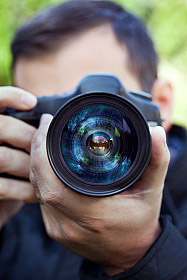

Building Businesses Since 1973

About Photography and Images
|
About Digital Camera Files
We are committed to a high quality product, we need good images to maintain that quality. Most professional photographers today have high resolution digital cameras capable of producing clear sharp image files (8 to 10 Mega-Pixel in High Quality JPEG or RAW format). However, most consumer base digital cameras generally capture images with too little resolution (file size/detail) to be used for this production process. Yes, even a 3.2 Mega-Pixel digital camera will only capture about 20 percent of the data needed to cover a front cover of a folder at 300 DPI. And many printers are now requesting 400 DPI files! These low resolution digital camera image files poorly represent detail and color, and will generally be pixilated and blurry if used. To make matters worse, most use high file compression to store the data which will distort the image and remove detail even more. Always use the "fine" or "highest quality" settings on any digital camera.
What to Shoot
Talk to your sales rep about what images might be best suited for your project. Consider what layouts will suit your project the best, vertical or horizontal. It is better to be a little too far back then too close to your subject. If you are going to the trouble of either taking photos, or are hiring someone to take them, then take lots of pictures. Lots and lots of them! You may find the need for the extra photos so get a wide range of pictures; close-up, full subject, with different lighting, from different angles, with different backgrounds. Get the most out of a photo shoot, whether it is only for this one project or not, then choose the best one to actually use.
When to Shoot
Get photography guidance from the designer early so you know you have the best images right from the start. This is important because some professional photographers have a waiting list. Photography can usually be done long before deadlines become a source of panic. You can shoot studio portraits anytime, but shooting outdoor photography is best done in the soft morning or late afternoon light or on a partly cloudy day when the subject will not have too much contrast or sharp shadows.
For the Photographer
The most common difficulty with photography is either low resolution or lack of proper image dimension. We need a vertical photograph for a vertical front cover. Be sure to capture more image area outside of the subject than you think you will need to allow for some cropping, bleed and proper dimensional fit. When furnishing edited digital files, always send along copies of the unedited or the original RAW format digital file whenever possible. The less changes made to a digital photo the more original detail it will have. Our professional graphic artist will be fully capable of touching-up, editing, color correcting and handling adjustments. When providing prints use glossy paper (8" x 10" or larger).
Photography “Hazards”
The best direction we can give any photographer, professional or amateur, is to turn your camera 90 degrees. Most cameras shoot in a horizontal rectangular format, so if used for a folder front cover, you will need to have a vertical photo. If you need a full panoramic photo to cross two or more adjacent pages, then shooting horizontal will be best. If sending photo prints, package them securely between sheets of cardboard so they will not be damaged or bent during shipping.
Use Glossy Photo Paper
Use only glossy photo paper for enlargements (at least 8" x 10" or larger). The alternative to glossy paper is normally called “satin finish”. This low glare finish is achieved by putting the image on a surface which contains tiny little bumps. This microscopic mountain range refracts the glare into smaller pieces and in various directions, thus reducing its clarity. To the scanner, this creates the illusion that the photograph is covered with small white dots and makes it look as if it is sprinkled with salt or dust. The image’s detail will suffer when these imperfections need to be removed. Get the best quality right from the start. Don’t waste the time and expense of hiring a good photographer on a paper that doesn't allow for a crisp clean image capture–ask for the right paper in advance so you don't have to pay for reprinting them.
Color or Black & White?
We recommend shooting most photos in color. It is relatively easy to make a black and white image (or Greyscale) from a color photo, however, to make a color photo from a black and white is quite a different story. If it’s certain that the end usage of the image will be black and white, then you might do so, because black and white traditionally contains better contrast if that is the end use. Many professional photographers prefer B&W for that reason. But when in doubt shoot color!
